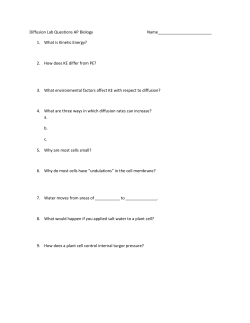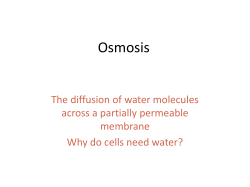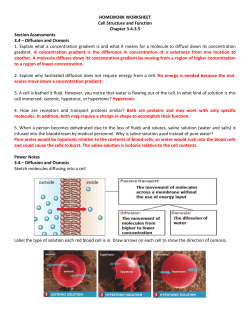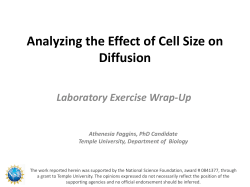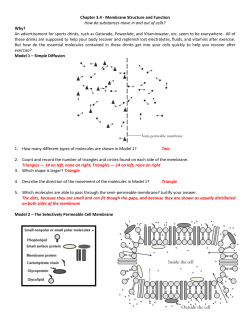
© Centura Foods Ltd
© Centura Foods Ltd 2 All substances are made up of sub-microscopic particles called molecules In gases (like air) the molecules can move freely In liquids (like water) the molecules can also move In solids the molecules are more or less stationary 3 Representation of molecules in a gas (a) (b) As a result of their random movements the molecules become evenly distributed 4 Next slide Diffusion As a result of this random movement, the molecules of a gas become evenly dispersed This movement is called DIFFUSION The scent of a hyacinth diffuses throughout a room The scent molecules diffuse from a region where they are concentrated (the flower) to regions where they are absent or in low concentration 5 6 One of the ways substances enter and leave cells is by diffusion If a substance is more concentrated outside a cell than inside, the molecules will tend to diffuse into the cell If a substance is more concentrated inside the cell than outside, the molecules will tend to diffuse out of the cell Diffusion gradient The molecules are more densely packed on the left and so they tend to diffuse into the space on the right. This is a diffusion gradient A diffusion gradient 7 Scale The scale of the following drawings is greatly distorted. Even if the cells were as large as they appear on the screen, the molecules would still be invisible particles 8 Diffusion of oxygen into a cell The concentration of oxygen molecules is greater outside the cell than inside So the oxygen molecules diffuse into the cell 9 10 Because the cell is using up oxygen, the concentration of oxygen inside the cell is always lower then the concentration outside. The diffusion gradient is maintained So oxygen continues to diffuse in 11 If all kinds of substance could diffuse into a cell there would be a danger that poisonous substances could diffuse in and kill the cell If all the substances in a cell could diffuse out the cell would lose essential substances (e.g. glucose) needed to keep the cell alive In fact, although the cell membrane does allow some substances (e.g. oxygen and carbon dioxide) to diffuse freely, it controls the exit and entry of nearly all other substances 12 Diffusion is slow For living processes it is effective only over short distances The distance from a cell membrane to the centre of the cell may be 0.1mm or less Diffusion is rapid enough to keep a cell supplied with oxygen and food Single-celled organisms 13 In a single-celled organism (such as Amoeba) the distance is so small that diffusion is rapid enough for the cell’s needs oxygen carbon dioxide maximum distance is 0.1 mm 14 Single-celled organisms are rarely more than 1mm in diameter Bacteria range from 1 - 10 microns (1-10 µ ) ( 1 µ is one thousandth of a millimetre) Diffusion is rapid enough for such small organisms 15 Inside the bodies of large animals, diffusion of oxygen into their cells is rapid enough For transport across the whole body, diffusion would be much too slow Large organisms have evolved transport systems (e.g. blood circulatory systems) that carry oxygen from outside the body to the cells inside 16 Earthworm diffusion takes place through the thin skin of the worm O2 diffuses in Section through worm’s skin 0.04mm the blood vessels absorb the O2 and carry it to the body CO2 diffuses out Question 17 Did you notice anything in particular about the earthworm’s ‘skin’ as seen in the section ? Have another look. How might this affect diffusion ? 18 Humans obtain their oxygen by diffusion But not through the skin Although the skin is well supplied with blood vessels, there are too many layers of cells for diffusion to be fast enough Humans have lungs and it is in these lungs that diffusion occurs 19 Human lungs windpipe lung diaphragm position of lungs in thorax heart human lungs 20 Lung Structure each tube ends up in a cluster of tiny air sacs. the air passages in the lung branch into finer and finer tubes A single air sac 21 blood supply to air sac diffusion of oxygen diffusion of carbon dioxide air breathed in and out O2 CO2 0.03 mm question 4 22 In mammals, birds, reptiles and amphibia, oxygen and carbon dioxide are exchanged by diffusion in the lungs In fish, this exchange of gases takes place by diffusion through the gills The oxygen dissolved in the water diffuses into the blood vessels in the gills. Fish 23 gill cover gills gill cover cut away gill filaments 24 Diffusion takes place through the surface of the gills Diffusion is a slow process The branching gill filaments offer a big surface area through which oxygen and carbon dioxide can diffuse In this way, the total diffusion through the gills is greatly increased The millions of air sacs in the lungs also vastly increase the area through which the gases can diffuse Plants 25 Plants have no special organs for breathing They have to rely on diffusion for their supplies of oxygen and carbon dioxide There are pores in the leaves and stems through which the gases diffuse In daylight, CO2 (for photosynthesis) will be diffusing in and O2 will be diffusing out In darkness, O2 will diffuse in and CO2 will diffuse out as a result of respiration 26 Leaf O2 and CO2 diffuse through pores in the epidermis the ‘veins’ bring water In a thin leaf, the diffusion distance is short O2 and CO2 diffuse into the spaces between cells 27 Question 1 Diffusion can normally take place in (a) a liquid (b) a solution (c) a solid (d) a gas Question 2 A fish breathes (a) water (b) oxygen dissolved in water (c) oxygen in the air (d) carbon dioxide dissolved in water 28 29 Question 3 Diffusion takes place as a result of (a) convection currents (b) air movements (c) natural movement of molecules (d) changes in temperature 30 Question 4 What is the approximate diameter of an air sac in the human lung ? (Slide 21) (a) 0.006 mm (b) 0.06 mm (c) 0.6 mm (d) 6.0 mm 31 Question 5 In a plant leaf, CO2 diffuses (a) into the air space between cells, (b) into the cytoplasm, (c) through the cell wall, (d) through a pore in the epidermis. The correct sequence is (a) a,b,c,d (b) c, b, d, a (c) d, a, c, b (d) d, c, a, b 32 Question 6 Which of these would you expect to diffuse freely through a cell membrane ? (a) carbon dioxide (b) water (c) proteins (d) oxygen 33 Question 7 Through which of these layers would you expect diffusion to be most rapid ? (a) (b) (c) (d) Question 8 34 The cells inside an earthworm receive oxygen via (a) diffusion into the blood vessels, (b) transport by the blood, (c) diffusion out of the blood into the cells, (d) diffusion through the epidermis. Which of the following is the correct sequence? (a) b, c, d, a (b) a, b, c, d (c) d, a, b, c (d) d, b, a, c 35 Answer Correct 36 Answer Incorrect 37 The earthworm’s ‘skin’ is only one cell thick. To reach a blood vessel, the oxygen has to diffuse over a very short distance and so is rapid enough to meet the earthworm’s needs. The single cell layer is an epidermis rather than a ‘skin’. single cell
© Copyright 2025
